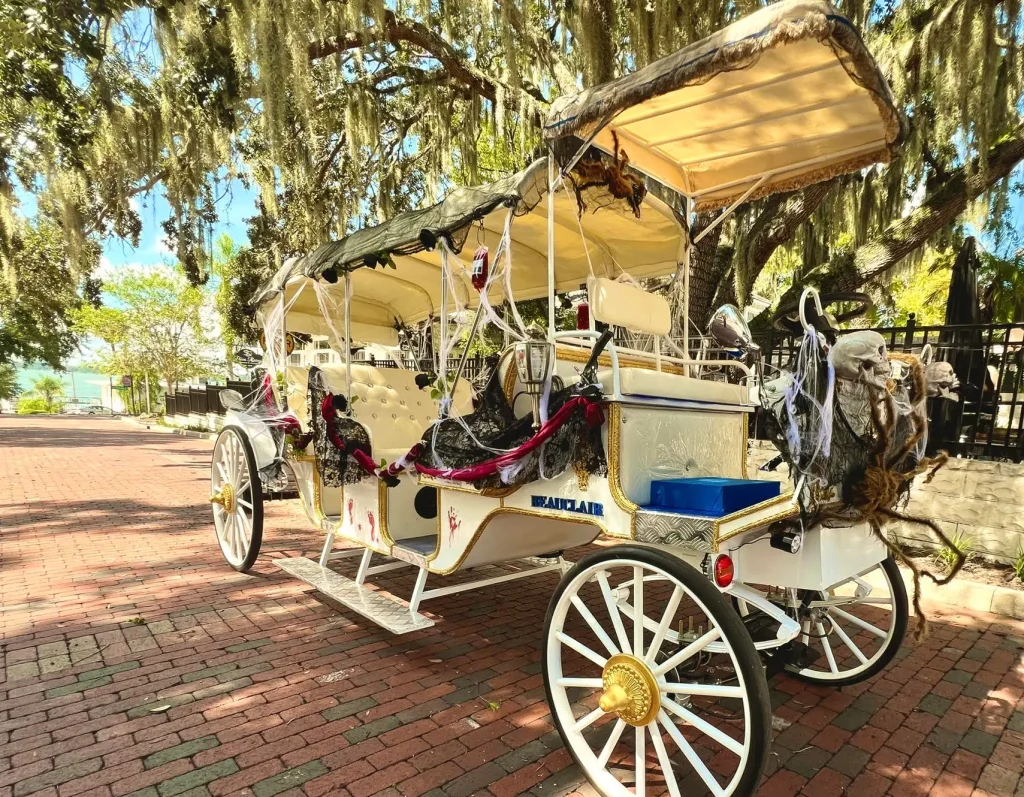Once upon a time, long ago (the 1980s), in a charming, not-so-faraway land called Old Naples, a royal carriage drawn by a fine white steed could often be seen clip-clopping along between the City Dock, Third Street South, and the Naples Pier around sunset. What a picture it made – especially when the carriages were filled with brides and grooms, and children all dressed up for a birthday ride. But as more people came, and more cars, it became less safe or comfortable for the gentle horse, and inconvenient in traffic. And so, the carriage rides ceased.
In other places – really faraway lands drenched in centuries of history, from Europe to the Far East – sightseeing by carriage has been a must-do experience for visitors, but traffic and animal welfare concerns created a real dilemma: how to hold onto the charm while keeping humans and horses safe.
Guadalajara, Mexico, was among the first heritage-rich cities to transition to a new, battery-operated horseless carriage. The fancy covered “calandrias” are all velvet and gold, with embossed leather seats and costumed drivers. In Brussels, Belgium, a joint venture between a carriage company and city officials resulted in a carriage inspired by the electric carriages of the 1830s. The first ones rolled out last year. Mumbai, India, now has eVictorias, reflecting the opulence of the original horse-drawn Victoria carriages in 1700s Bombay. Scores of other cities around the world are moving in that direction.
Mount Dora

Spider webs and skeletons adorn an Olde Mount Dora e-carriage in the fall. Photo courtesy of Olde Mount Dora Carriage Company.
The historic Central Florida town of Mount Dora, founded in the 1880s as a winter retreat for wealthy sportsmen, was the first town in the U.S. to introduce the new horseless carriages. Two very creative entrepreneurs, a pilot and a real estate agent, established the Olde Mount Dora Carriage Company to create a Victorian-style, clean, and green carriage service that complements the city’s charm. The shiny white carriages that rolled out in 2022 have a fun sense of glam with available extras such as treat boxes, chocolates, wine, and sparkling wine.
Mount Dora has so many themed festivals year-round that it is known as the Festival City of Florida. Magic is especially in the air during the holidays, as the entire town immerses itself in over two million lights! mountdoracarriageco.com; www.mountdorabuzz.com/fall-festivals
Retiring the Reins
Chicago, San Antonio, Salt Lake City, Breckinridge, Colorado, Key West, and many international cities, including Montreal and Toronto, already have bans on horse-drawn carriages. In gracious southern cities, including Savannah, Charleston, Key West, St. Augustine, and Biloxi, concerned citizens, animal welfare activists, and civic leaders are in heated discussions to ban or restrict horse-drawn carriages.
Philadelphia’s last horse-drawn carriage company ceased operations in 2023. Meanwhile, animal advocate Janet White, founder of Carriage Horse Freedom, was already working toward bringing e-carriages to her native city. Her Philadelphia e-carriage tour program is anticipated to start in 2026. Until then, her first e-carriage Caroline is busy appearing at special events and visiting other cities where interest in e-carriages is high. www.carriagehorsefreedom.com

Janet White with her first e-carriage, Caroline, at the May Day Parade with students at Bryn Mawr College. Photo courtesy of Janet White.
Royal Carriages of New Orleans decks out their mules, a cross between a horse and a donkey known for their strength and hardiness in extreme temperatures, to pull their carts. They’re not elegant, but they are very cute. Still, there are movements to either ban cars or the mule-drawn carriages (or both) in the French Quarter.
Last month, after decades of accidents, animal injuries, and deaths, the Central Park Conservancy in New York officially advocated for the ban of horse-drawn carriages from Central Park, citing visitor safety and a kinder future for the animals.
So here’s my question: Is the new e-carriage awesome enough to reconcile the graceful ambience and Old-World charm with 21st century realities? Janet White is sure of it. Maybe the enchanting clip-clop of hooves could be achieved with an audio loop. And come to think of it, a splendidly appointed e-carriage could be more appealing than riding directly behind a horse’s rear end.
Personal, Slow, and Meaningful
A few places where horse-drawn carriages make sense
Due to public health and safety and animal safety issues, horse-drawn carriage tours are no longer compatible with the realities of modern, heavily trafficked areas. While it’s time to turn the page on their use in city tourism, some rural horse-drawn carriage destinations still exist.

Where form meets function on Mackinac Island, Michigan, cars are prohibited. Locals and tourists get around by horse-drawn carriage.
Cars have long-been banned on Mackinac Island, which is eight miles long and three miles wide. Mackinac Island Carriage Tours is the world’s oldest and largest continually operated horse and buggy livery with approximately 100 carriages and more than 400 horses. Their high-stepping hackneys are bred for their power and serenity. When the tourists and summer residents leave, most of the horses go on vacation until spring (mict.com). In Amish country, Abe’s Buggy Rides in Bird-in-Hand, Pennsylvania, offers country rides through Amish farmland and sites dating to the 1700s. It’s a kids’ favorite and pets are welcome (abesbuggyride.com). And to book the absolute ultimate in private royal horse-drawn carriage experiences, Windchase Farm, headquartered in Central Florida, provides exquisite White Shire horses and liveried carriages for milestone events anywhere in the state. Drool over the photos at windchase.farm.